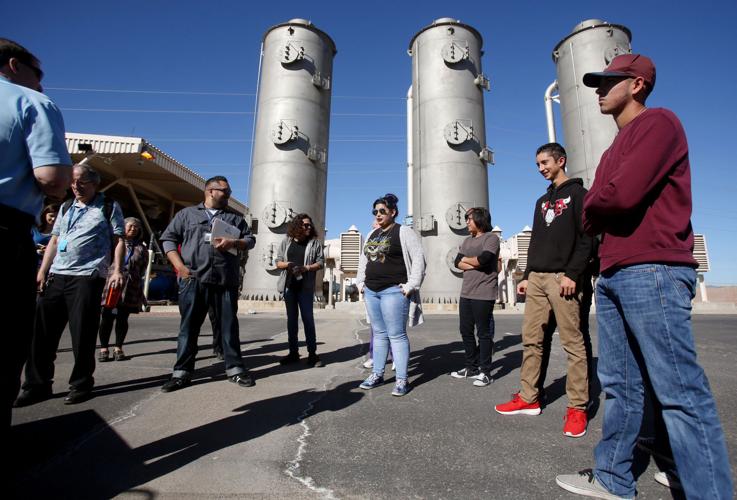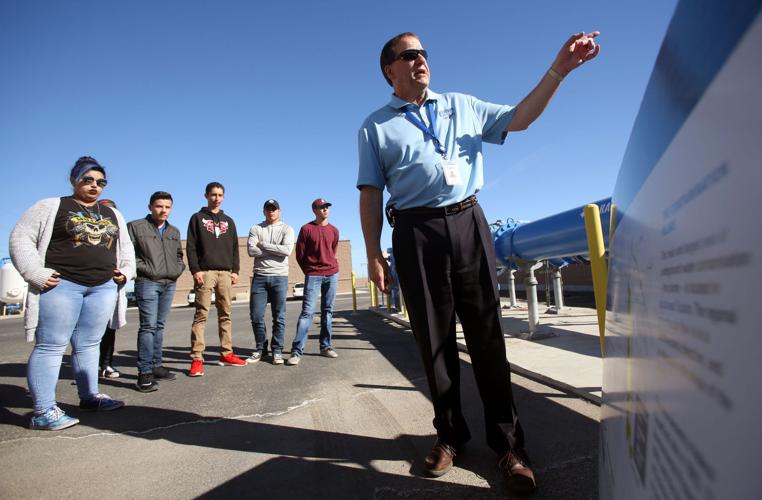Advancements in the treatment of contaminated south-side water have left Tucson Water officials looking to shut down a 22-year-old plant they say is no longer necessary, but still required by law.
A newer treatment plant completed in 2014 removes all the same contaminants as its older counterpart in addition to the carcinogen 1,4-dioxane, which was recently found to be more dangerous than previously thought, said Jeff Biggs, Tucson Water’s administrator of strategic initiatives. The progress has rendered the old plant obsolete, he said.
“It’s redundant now and it’s costing money unnecessarily,” he said.
Contaminated water has plagued the lower-income, largely Hispanic south-side community since the 1950s when defense-related industries used the carcinogen trichloroethylene, known as TCE, as an industrial degreaser and dumped it into the soil and unlined wells.
For almost 30 years, south-side residents unknowingly drank and bathed in contaminated water. Studies link long-term exposure to TCE to diseases like kidney cancer, liver cancer and blood cancer.
Tucson Water began operating a treatment plant, funded by the industries that originally polluted the groundwater, at the Tucson International Airport Area Superfund Site Area A in 1994. The area contains the contaminated groundwater plume that extends north from Los Reales Road to just past Irvington Road. The plume is bounded on the west by Interstate 19 and the Santa Cruz River, and on the east by South Sixth Avenue and Nogales Highway.
Over the past 22 years, 5,303 pounds of TCE have been removed from the water. The first engineers of the original TIAA Superfund site plant believed enough TCE would have been removed by now to close the plant.
But it could be another 30 years before enough TCE is removed to halt the treatment system, estimates Chad LaPora, the environmental and regulatory compliance supervisor for Tucson Water.
The original treatment plant stripped water of contaminants of concern including TCE but did not remove the carcinogen 1,4-dioxane from the water. That wasn’t a problem until the EPA discovered 1,4-dioxane was more dangerous than previously thought.
Tucson Water built the new Advanced Oxidation Plant to target both TCE and 1,4-dioxane using ultraviolet light combined with hydrogen peroxide to rid the groundwater of toxic chemicals.
The groundwater plume near Tucson International Airport was declared a federal Superfund site in 1983. The parties responsible for polluting the water at the TIAA Superfund Site Area A and now legally bound to clean it up are the U.S. Air Force; city of Tucson; Tucson Airport Authority; Hughes Aircraft Co., acquired by Raytheon in 1997; and McDonnell-Douglas Corp., acquired by Boeing in 1997.
Last month the EPA held a public forum at El Pueblo Activity Center to propose amendments to the 1988 record of decision, which laid out cleanup plans for the Superfund site. The EPA’s proposed amendments would allow for the closure of the older treatment plant and add 1,4-dioxane to the list of contaminants of concern.
The EPA will accept public comment on proposed changes to the Superfund site by letter or email until April 21.
RESIDENTS DON’T
TRUST WATER
The legacy of toxic dumping in the south side has left some residents suspicious of treated water coming from the Superfund site.
At last month’s forum, residents voiced fears about continuing family health issues including cancers and the chronic autoimmune disease known as lupus. Some demanded the EPA conduct a study to determine whether these diseases are linked to the contaminants.
EPA toxicologist Gerry Hiatt responded at the forum that although the EPA uses health-risk assessments to make decisions at Superfund sites, the EPA is not a health agency.
“We don’t have physicians working for us that can go into a community and evaluate the health status of a community or talk to people who’ve had health issues and may have been affected by the contamination,” Hiatt said.
Together with Tucson toxicologist Dr. Farshad Shirazi, south-side resident Linda Robles is in the process of creating a house survey to take to her neighbors to find how many illnesses have resulted from the water contamination. She’s also started a community group called the Environmental Task Force.
“They just keep finding more chemicals,” Robles said. “Where are these coming from?”
CHROMIUM-6
Tucson Water is also braced for the possibility that another chemical may require treatment at the Superfund site. Chromium-6, the carcinogen featured in the 2000 movie “Erin Brockovich,” has been under scrutiny by the EPA since 2010. The agency told PBS in 2013 that it would release findings from its review of chromium-6’s health effects this year, but it has not yet done so. EPA spokeswoman Enesta Jones did not respond to the Star’s questions about when the study will be released.
In November, Tucson Water found chromium-6 concentrations of up to 8.8 parts per billion in TIAA Superfund Site Area A wells, which water officials say is safe. Concentrations are even lower — 1.6 parts per billion — after the groundwater from all Area A wells is blended together before distribution for drinking, LaPora said.
The EPA hasn’t yet established a threshold for safe consumption of the carcinogen, but California established a legal level of 10 parts per billion and a public health goal of .02 parts per billion.
In the event that chromium-6 levels rise at the Superfund site or the EPA’s review finds the contaminant more dangerous than previously thought, Tucson Water will need to construct a new plant to treat the water for that chemical, Biggs said.
Tucsonan Yolanda Herrera, 64, has watched the south-side water cleanup from the beginning. She applauded Tucson Water for its cleanup efforts.
“I was glad they were more proactive than reactive,” Herrera said.
While Herrera said she would support a health-survey effort, she said her neighbors’ distrust of the cleanliness of Tucson Water is misguided. She co-chairs the Unified Community Advisory Board that meets quarterly with Tucson Water officials and representatives from the industries responsible for contaminating south-side water to talk about the cleanup progress.
A second-generation board member, she has seen first-hand the damaging effects of TCE.
Her mother developed a cancerous tumor after drinking the contaminated water and had to have part of her jaw removed. She suffers immense pain every day, Herrera said. Herrera said some of her siblings have also gotten cancer and her family has experienced stillborn babies and had others born with heart and kidney problems.
EDUCATING YOUTH
University of Arizona College of Education associate professor Kristin Gunckel developed a high school curriculum, with funding from the National Science Foundation, that uses computer modeling to teach students about the TIAA Superfund site groundwater contamination.
Over the past school year, she’s worked with science teachers from Desert View and Sunnyside high schools to teach students about their groundwater.
“They didn’t really know about it,” Gunckel said of the water contamination, “but as they started learning about it they became much more interested and engaged.”
On March 9, five Sunnyside high schoolers took a tour of the two plants at TIAA Superfund Site Area A.
Quiet and reserved, the students let the information of the history of south side’s water contamination seep in.
Sunnyside senior Francisco Martinez said he felt it was important to learn about the water contamination. His grandmother lived off Drexel Road when the tap water was contaminated, so he was familiar with the issue.
Local activist Herrera tagged along on the tour and spoke to the kids about her advisory board, whose members are aging, she said.
“I think it’s imperative that we do have kids at the table,” Herrera said. “We need the younger generation to have the knowledge to hold the government agencies’ feet to the fire.”






